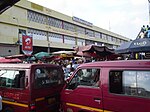Agbogbloshie is a nickname of a commercial district on the Korle Lagoon of the Odaw River, near the center of Accra, Ghana's capital city in the Greater Accra region. Near the slum called "Old Fadama", the Agbogbloshie site became known as a destination for externally generated automobile and electronic scrap collected from mostly the western world. It was a center of a legal and illegal exportation network for the environmental dumping of electronic waste (e-waste) from industrialized nations. The Basel Action Network, a small NGO based in Seattle, has referred to Agbogbloshie as a "digital dumping ground", where they allege millions of tons of e-waste are processed each year.The most exhaustive study of the trade in used electronics in Nigeria, funded by the United Nations Environment Programme (UNEP) and the Basel Convention, revealed that from 540 000 tonnes of informally processed waste electronics, 52% of the material was recovered.According to statistics from the World Bank, in large cities like Accra and Lagos, the majority of households have owned televisions and computers for decades. The UN Report "Where are WEEE in Africa" (2012) disclosed that the majority of used electronics found in African dumps had not in fact been recently imported as scrap, but originated from these African cities. Agbogbloshie is situated on the banks of the Korle Lagoon, northwest of Accra's Central Business District. Roughly 40,000 Ghanaians inhabit the area, most of whom are migrants from rural areas. Due to its harsh living conditions and rampant crime, the area is nicknamed "Sodom and Gomorrah".The Basel Convention prevents the transfrontier shipment of hazardous waste from developed to less developed countries. However, the Convention specifically allows export for reuse and repair under Annex Ix, B1110. While numerous international press reports have made reference to allegations that the majority of exports to Ghana are dumped, research by the US International Trade Commission found little evidence of unprocessed e-waste being shipped to Africa from the United States, a finding corroborated by the Massachusetts Institute of Technology, Memorial University, Arizona State University, UNEP, and other research. In 2013, the original source of the allegation blaming foreign dumping for the material found in Agbogbloshie recanted, or rather stated it had never made the claim that 80% of US e-waste is exported.Whether domestically generated by residents of Ghana or imported, concern remains over methods of waste processing — especially burning — which emit toxic chemicals into the air, land and water. Exposure is especially hazardous to children, as these toxins are known to inhibit the development of the reproductive system, the nervous system, and especially the brain. Concerns about human health and the environment of Agbogbloshie continue to be raised as the area remains heavily polluted. In the 2000s, the Ghanaian government, with new funding and loans, implemented the Korle Lagoon Ecological Restoration Project (KLERP), an environmental remediation and restoration project that will address the pollution problem by dredging the lagoon and Odaw canal to improve drainage and flooding into the ocean.





